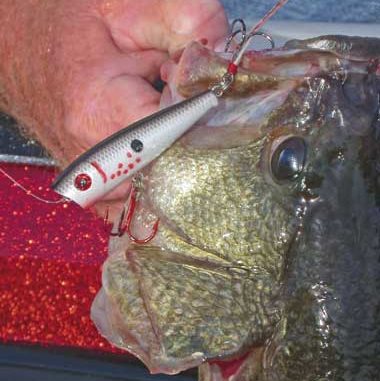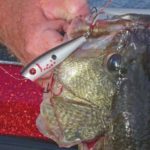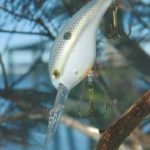
Many of our fishing techniques in Louisiana originated with our Indian anchestors.
In June, I prefer to fish Lake Claiborne in Homer because it has really good structure, like stumps and points, it holds numbers of bass, even though it doesn’t have a lot of big fish, and it’s fun to fish there.
During June, the bass will be moving away from the bank and out toward the structure. On Lake Claiborne, I’ll search for hard bottoms and stumps.
Early in the morning, I’ll start fishing the Spit-N-King around boat docks and on banks 5 feet deep or less, and fish boat docks early with a topwater lure.
As the sun rises, I’ll pull out of the shallow water and begin looking for offshore structure, including points, creek-channel drops, isolated stumps, hard bottoms (whether mussel or rock) and grass. Lake Claiborne has some grass, but not much. I’ll fish offshore structure there not for 12-pound bass but rather 3-pound bass or better. Claiborne’s offshore structure isn’t really deep, and doesn’t get much fishing pressure.
During June, the bass will be feeding heavily on shad, and I’ll catch bass 8 to 12 feet deep with a Strike King Series 5 or Series 6 in the Sexy Shad color. No other colored lure better resembles the shad than the Sexy Shad. Some people may think Sexy Shad is a gimmick. But when someone like Kevin VanDam wins three $100,000 bass tournaments in one year with the Sexy Shad color, it has proved it can catch bass.
I’ll fish this bait on either 10- or 12-pound-test Gamma fluorocarbon line. The Series 5 will hit the bottom in about 10 feet of water on 12-pound-test fluorocarbon line. A Series 6 will hit the bottom at about 15-feet deep.
If the bass are deeper than that, I’ll fish the Series 6 on 10-pound-test fluorocarbon line. I prefer to fish crankbaits on fluorocarbon line because it has a smaller diameter than monofilament line, making it easier to get your crankbaits down deeper. I’ve also learned that fluorocarbon line is much more sensitive than monofilament, letting me know if I’m hitting a rock or a clay bottom or stumps, running that crankbait through limbs and increasing my ability to feel the bottom.
Make sure your crankbait will dive deeper than the bottom you’re fishing because you want the bill to dig into the bottom and bounce off rocks, stumps, logs and any other type of structure.
The crankbait is designed to do more than just catch bass. It’s also your hands under the water. Once you learn to fish the crankbait, you can feel how the lure is moving on the bottom, what kind of structure it’s hitting, and bounce the crankbait off that structure.
Many fishermen will try to run their crankbaits over the tops of structure, but you’ll get more bites if you’ll run that crankbait into structure and let it bounce off it to get a reaction strike. Often a spot where I’ve caught the bass with a reaction strike will have a school holding on it. That reaction strike will charge up the other bass in the school, causing them to go on a feeding spree.
On Lake Claiborne, crappie fishermen often sink brush in the water. If I run my crankbait into a stump and catch a bass, then I can assume the bass are holding on stumps. As long as the bass are biting a crankbait, I’ll fish the crankbait.
If the bass stop biting the crankbait, and the bass are holding on brushpiles, then I’ll use a 10-inch Strike King Anaconda with its big tail and swimming action. I’ll rig the Anaconda Texas-style so it will come through the cover easily.
If the bass are concentrating on a stump or a hard bottom, I’ll fish the Anaconda on a Carolina rig, and use about a 3-foot leader.
Remember that in June, in Louisiana, our water isn’t just warm; it’s hot. The water temperature usually will be in the low 80s. When the water temperature is this hot, the bass on this lake prefer a big-profile bait. Their metabolism speeds up due to the hot weather, and they have to eat a lot.
Lake Claiborne receives intense fishing pressure in the early spring. However, by June, the fishing pressure starts to wane, and you often can find an unmolested school of bass on offshore structure that will hold there throughout the summer. But few fishermen will fish offshore looking for bass.
The later in the day you fish offshore, the more active the bass become — particularly from 10 a.m. to 4 p.m. The bass will feed early in the morning and then later go on a feeding spree in mid-day — often biting on every cast. I’ve caught two bass at a time on one crankbait in the middle of the day on Lake Claiborne in June.
At this time of year, you’re not fishing for resident bass like the ones that live on a boat dock or a stump. You’re fishing for bass schooled up on offshore structure. Usually, when you catch one bass, you’ll catch two or three quickly. Then, you may have to change colors.
For me, I may change from a Sexy Shad to a blue/chartreuse bait. If the bass stop hitting the crankbait, I’ll either fish the Iguana Texas-style or on a Carolina rig.
When I fish Lake Claiborne, I expect to catch 2- to 4-pound bass. However, the lake can produce 7-pounders. If you move out to the structure, you’ll catch numbers of 3- and 4-pound bass.
I don’t like to sit in the sun in the middle of the day, fish hard and not catch any bass. Catching bass is more fun then fishing for bass. In June, Lake Claiborne gives me the best opportunity to catch the most bass.





